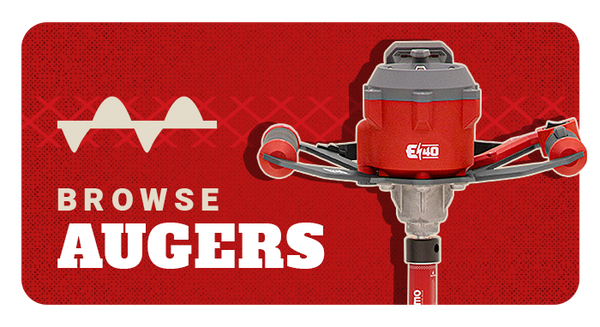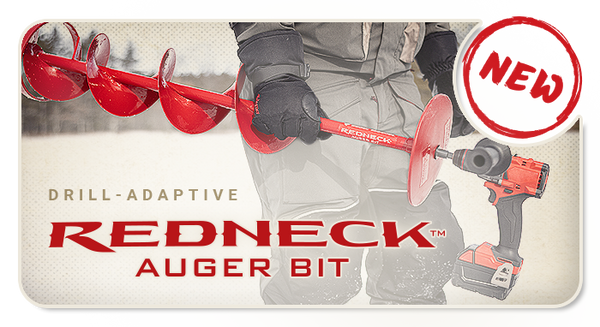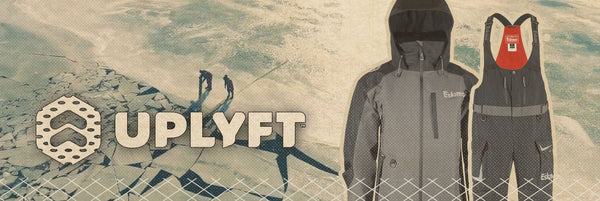Kyle Agre | National Pro Staff | Brewer-Agre Outdoors
Originally published in our 2020 Ice Fishing Annual
There is no guarantee that the ice we set foot on will sustain us and our gear. Regardless of the time of year, we accept a level of risk when venturing out on the ice. Should the worst-case scenario occur, caution and diligence to ensure the proper equipment is available and on-hand are always warranted. Conversations with two ice anglers who separately faced falling through the ice share their perspective and experiences with just how quickly it can all happen.
East coast ice angler Tyler Hanson was enjoying a day on the ice participating in a local Vermont derby with his son when things went terribly wrong. Hanson, an avid angler and outdoor enthusiast, checked the ice at the access several times, noting that they had nearly 10” of solid ice beneath their feet. Proceeding onto the ice they set up their shelter and spread out tip ups surrounding their base camp. It was a February day like so many other ice anglers have experienced and enjoyed. Thrilled to see a flag up, the father-son pair raced to bring in their catch. After landing a nice pike, they headed for the weigh-in station a few hundred yards down the lake, walking single file toward their destination. Following a set of ATV tracks Tyler was confident in the security of the ice beneath their feet. That confidence was soon lost as he felt the ice buckle and give way underneath him. “I was shocked as I was going in. The water was cold, and I mean COLD! But my first thought was of my son behind me.” Luckily, the youngster was following far enough back to be able to stop while still on safe ice.
Tyler was wearing a newly purchased set of Eskimo Keeper bibs when he fell through the ice. “I never went fully in the water” as the Uplyft™ float-assist in the bibs kept him buoyant and prevented him from completely submersing in the frigid water. His mind racing, he now turned his thoughts to how to get out of the water and back up onto the ice. “I was still holding the fish through it all. I threw it up onto the ice and tried to get out of the water. Because of what I was wearing, it was so much simpler to get out of the water.”
The Keeper Bibs gave the lower half of his body enough buoyancy to allow him to “slide” out of the water and onto the ice. They safely made it back to their portable shack to warm up before eventually weighing in the pike and taking 4th place in that day’s derby. The story may not have had as happy an ending if Tyler were not wearing a float assist suit. “I’m definitely getting the jacket to go with them!” he stated. “I won’t go on the ice again without them on.”
Keith Horning was fishing Saginaw Bay on Lake Huron for walleye in January on a spot they had fished a number of times prior. Hitting the ice with a buddy, they loaded their gear on an ATV and pulled a sled behind as they set out on the ice. They knew ice conditions on Saginaw Bay could vary and that they needed to be cautious. Checking the ice early on they felt safe knowing that they had 9-10” of good ice on which to fish. The spot they were targeting was not as productive as they had hoped so they decided to leave their portable shelter and push further out in search of a rock pile that often held fish. All of the holes around their base camp were at 9” of ice, so they didn’t give it any thought that it might not be safe.
As they followed the guidance of their GPS toward their destination the ATV carrying both anglers, their auger, electronics and rod/reel combos suddenly dropped from beneath them, falling back end first into the waters of Saginaw Bay. With his friend nowhere in sight, Keith felt his leg caught on the ATV beneath the water, holding him down, eyes deep in the icy waters. He struggled to break free from the grip that the machine held on him, barely able to surge up to get a breath of air. After what seemed like an eternity, he broke loose.
“As soon as my legs came free from my quad, the Eskimo bibs pushed my legs up.” Horning shared. He struggled to get out. “Every time I tried to grab onto the ice it broke loose. The bibs kept my legs up so that I was able to find secure ice and slide out of the water like a seal.” He was also wearing the Eskimo Keeper flotation assist bibs that day. Keith’s fishing companion was somehow able to get out of the water as well.
They now found themselves 1½ miles from their portable shelter, soaking wet and freezing cold. The pair made it back to the shelter, turned the heat on high and called for help. “My memory of going into the water was at first fear, then my brain kicked into survival mode. We needed to get out of there!” Horning added, “I’m a big guy. It had everything to do with those bibs being able to float my legs up so I could get out.”
Looking back at the incident, Horning shared “I’ll never set foot on the ice again without my Eskimo suit”, and he anticipates keeping a stronger focus on “reading the ice for changes” as he travels from spot to spot in order to avoid a situation like this again.
The conversation of ice safety all too often takes place only at first ice, when frozen lakes are slowly building enough ice to safely support anglers and their gear. The stories of these two anglers demonstrate the need to keep ice safety in the forefront of our minds every time we set foot onto the ice, regardless of what point in the season we find ourselves.
Some important safety precautions that every ice angler should take include:
- Tell someone where you are going and when you expect to return
- Use a spud bar to test the ice, or an auger to drill a test hole every time before venturing out
- Check the ice often when on unfamiliar areas of the lake
- Bring a length of rope along and always keep it accessible
- Carry or wear a life preserver when on the ice, or wear clothing with float-assist technology
- Carry ice picks
- Wear ice cleats on your boots
- Travel in single file on the ice, with enough space between anglers to allow for a safe stopping distance—whether on foot, ATV, snowmobile or vehicle
Ice safety isn’t a sometime thing, it’s an every-time thing. Don’t take it for granted and you’ll be much more likely to avoid life threatening situations like those shared by these two anglers. For more details on their stories, be sure to follow and listen to the 2020-21 season of the ShackTalk ice fishing podcast, featuring interviews with both Tyler Hanson and Keith Horning.











